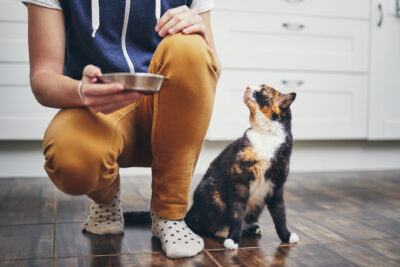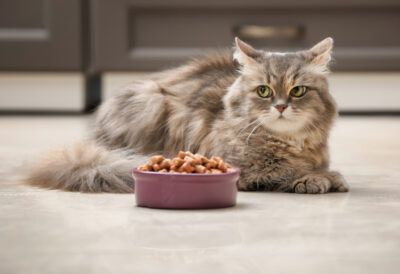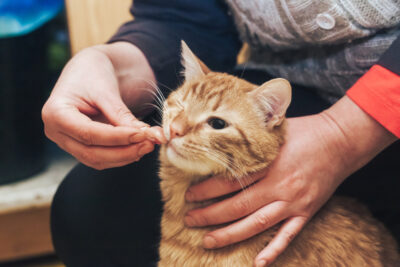Limited Ingredient Cat Food: 6 Vet-Approved Picks

All featured products are chosen at the discretion of the GreatPetCare editorial team and do not reflect a direct endorsement by the author or reviewer.
Some cats can eat anything; others aren’t so lucky. For felines with cat food allergies or sensitivities, eating the wrong diet could cause many unpleasant health issues. Luckily, a targeted approach to nutrition can help. And that’s where limited-ingredient cat food comes in.
True food allergies are relatively rare in cats (affecting only 1 percent of felines) [1]. However, food intolerance can trigger similar reactions, including itchy skin, vomiting, and diarrhea.
If your cat suffers from either condition, a limited ingredient diet could make mealtime more manageable. So here’s a helpful guide that explains what limited ingredient cat food is, which formulas vets recommend, and how to choose the right one for your cat.
What is Limited Ingredient Cat Food?
As you might expect, limited ingredient cat food generally contains fewer ingredients than traditional cat food formulas. This can help reduce the risk of allergic reactions or sensitivities caused by certain cat food ingredients.
However, neither the U.S. Food and Drug Administration (FDA) nor the Association of American Feed Control Officials (AAFCO) regulates the term “limited ingredient” in pet food.
While formulas can vary from brand to brand, they’re often free of artificial flavors, fillers, and other ingredients that could trigger adverse reactions. These may include common cat food allergens, such as animal proteins like beef, chicken, or fish.
Here’s what typically makes up a limited-ingredient diet:
- Single protein source: Most limited-ingredient diets use just one type of meat. This is often a novel protein, meaning one your cat hasn’t eaten before. Common choices include rabbit, duck, or lamb. Some recipes even contain kangaroo or alligator!
- Single carbohydrate source: These usually come from veggies like peas or potatoes, or grains like oatmeal or rice.
- Healthy fat: Key for any cat diet, fats like omega-3 fatty acids support skin and coat health.
- Vitamins and minerals: These ensure your cat receives complete and balanced nutrition, even on a diet containing fewer ingredients.
Limited ingredient formulas come in wet, dry, and canned forms, and even as limited ingredient cat treats. Some are available over the counter (OTC), while others require a veterinary prescription.
Many limited-ingredient cat diets are grain-free. However, it’s worth noting that grain allergies in cats are uncommon. So, unless your vet says otherwise, a limited ingredient diet with grains is still a great option.
Why Vets Might Recommend Limited Ingredient Cat Food

Veterinarians often recommend limited-ingredient cat food for cats with food allergies, food sensitivities, or inflammatory bowel disease (IBD). These conditions can cause symptoms like:
Switching to a food with fewer ingredients—especially one that avoids common allergens—can help manage or even eliminate these symptoms.
The most common triggers for cat food allergies are animal proteins, such as beef, chicken, and fish. Less common food allergens include wheat, dairy, egg, and corn.
Even for cats without diagnosed food allergies, vets often suggest limited-ingredient cat food for food elimination trials. This is where cats eat a very simple diet for 8-12 weeks to identify potential allergens.
In these trials, strict adherence is key. Your vet may prescribe a limited-ingredient diet or a hydrolyzed protein diet, where the proteins are broken down so they don’t trigger an immune response. This is to avoid the risk of cross-contamination that may occur with OTC limited ingredient formulas.
Vets do not recommend limited ingredient diets for healthy cats. That would limit future options for novel proteins if they develop a food allergy later in life.
Best Limited Ingredient Cat Food: 6 Vet Picks to Consider

Every cat is unique. So there is not one “best” limited ingredient cat food that will work for all cats with food allergies or sensitivities. However, depending on your cat’s specific health needs, here are six vet-recommended limited-ingredient cat foods to consider.
From limited-ingredient wet cat food and dry cat food to novel proteins, you’re sure to find an option your kitty will love.
Royal Canin Selected Protein PR Dry Cat Food
This prescription limited ingredient dry cat food from industry-leader Royal Canin features rabbit as a novel protein. It also includes omega-3 fatty acids to help promote healthy skin and coat. It is highly palatable and digestible, so your cat should enjoy munching on it at mealtime. This limited-ingredient rabbit cat food diet is also ideal for food elimination trials.
Highlights
- Single animal protein source: rabbit
- Additional protein from peas and hydrolyzed soy
- Supports healthy skin and coat
- Highly palatable and easy to digest
Things to consider
- Requires a veterinary prescription
- Higher in carbs and lower in fat than some other limited-ingredient formulas

Hill’s Science Diet Adult Sensitive Stomach & Skin Wet Cat Food (Duck and Vegetable)
This limited-ingredient wet cat food is grain-free and contains a balanced blend of vegetables and nutrient-rich duck. This diet is easily digestible and supports healthy skin and coat. It’s also available without a prescription.
Highlights
- Novel protein source is duck
- Ideal for cats allergic to grains
- Contains natural fibers to aid healthy digestion
- Omega-6 fatty acids and Vitamin E support healthy skin and coat
- Over-the-counter availability
Things to consider
- Limited flavor varieties
- Some pet parents recommend adding water to create an appealing gravy

Blue Natural Veterinary Diet NP Novel Protein Dry Cat Food (Alligator)
Odds are that most cats have not consumed alligator meat. So this unique alligator-based formula is an ideal limited-ingredient canned cat food. (Especially for highly allergic cats who cannot tolerate other novel proteins.)
Blue Natural Veterinary Diet NP is available over the counter without a veterinary prescription. The recipe is free of chicken, soy, and wheat. Plus, it features two sources of omega-3 fatty acids, antioxidant-rich ingredients (vitamins E and C), and fiber.
Highlights
- Novel protein source is alligator
- Rich in healthy fats and antioxidants
- Contains fiber to support healthy digestion
- Free of chicken, soy, and wheat
- Available without a prescription
- Also comes in canned wet cat food
Things to consider
- This may be a tough sell for picky kitties, though many pet parents say cats love the taste

Purina Pro Plan Focus Sensitive Skin & Stomach Dry Cat Food (Lamb & Rice)
This simple, single-protein cat food from Purina Pro Plan features lamb as its novel animal protein source. It also contains rice and oatmeal as carbohydrates, so it’s not a good fit for cats with grain allergies. The limited ingredient dry cat food formula is fiber-rich and easy to digest, with plenty of antioxidants to support immune health.
Highlights
- Novel protein source is lamb
- Rich in antioxidants and fiber
- Easily digestible carbohydrates
- OTC and widely available
Things to consider
- Not ideal for cats with grain allergies
- Lamb is not all that uncommon in cat food, so may not be novel for some

Rayne Nutrition Rx TheraDiet Rabbit-MAINT Chunky Stew for Cats
This prescription limited ingredient wet cat food comes in a chunky stew format cats love. It features tasty rabbit, prebiotics to promote beneficial gut bacteria, and algae as a source of omega-3 fatty acids. It is easily digestible and free of potential food allergens like corn and wheat. This diet is appropriate for food elimination trials.
Highlights
- Novel protein source is rabbit
- Easily digestible
- Highly palatable
- Healthy source of omega-3 fatty acids
- Prebiotics to support a healthy gut
Things to consider
- Requires a prescription
- May have limited availability

BLUE Natural Veterinary Diet HF Hydrolyzed for Food Intolerance
This prescription dry food from BLUE Natural contains hydrolyzed salmon protein, making it ideal for elimination trials or severe food allergies and sensitivities. Flaxseed provides a healthy source of omega-3 fatty acids. And ingredients like vitamins E, Vitamin C, and kelp support a healthy immune system.
Highlights
- Hydrolyzed proteins are broken down into parts too small to trigger reactions
- Omega-3 fatty acids from flaxseed
- Antioxidants to support a healthy immune system
Things to consider
- Fish is a common allergen, so not a good choice for cats with that allergy or sensitivity

Limited Ingredient Cat Food Buyer’s Guide
Now, let’s discuss some advice for selecting the limited ingredient diet that’s right for your cat.
- Most importantly, talk with your vet first. If your cat undergoes a food elimination trial, your vet can tell you exactly which ingredients to avoid. That should help you narrow down the options. Also, ask your vet which diets or brand they’ve seen work well for their other cat clients.
- Read labels carefully. Even limited-ingredient diets can contain allergens that may trigger a reaction in your cat.
- Look for the AAFCO (Association of American Feed Control Officials) label on the packaging. This indicates that the food provides complete and balanced nutrition for specific life stages.
Finally, here are a few tips to consider when feeding your cat a limited ingredient diet:
- Switch to the new diet gradually. Your cat’s digestive system will need at least a few days to adjust to the new diet. Start with a mix of 75 percent old diet and 25 percent new diet. Then gradually increase the percentage of the new diet a bit each day until your cat is eating only the new food.
- Watch for changes in your cat’s symptoms, such as less itching/scratching and reduced vomiting and diarrhea. By design, limited-ingredient diets are less likely to cause side effects because they do not trigger food allergies. However, you still need to stay alert for any adverse reactions when you start your cat on a new diet.
- Tell your vet about any changes in your cat’s symptoms, for better or worse. Your vet may recommend trying a new diet if your cat’s symptoms aren’t improving as expected. And even if the limited-ingredient diet is helping, your cat may require additional treatment (e.g., anti-itch meds or probiotics). Ask your vet what else you can do to ease your cat’s distress.
- Be patient! Food allergies can take time to get under control. Work closely with your vet to ensure that your cat is eating the proper diet to manage their food allergy.
REFERENCE
- Olivry, Thierry, and Ralf S Mueller. “Critically appraised topic on adverse food reactions of companion animals (3): prevalence of cutaneous adverse food reactions in dogs and cats.” BMC veterinary research vol. 13,1 51. 15 Feb. 2017, doi:10.1186/s12917-017-0973-z









